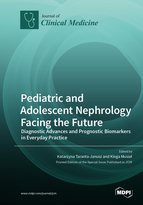Pediatric and Adolescent Nephrology Facing the Future: Diagnostic Advances and Prognostic Biomarkers in Everyday Practice
A special issue of Journal of Clinical Medicine (ISSN 2077-0383). This special issue belongs to the section "Nephrology & Urology".
Deadline for manuscript submissions: closed (20 September 2021) | Viewed by 45696
Special Issue Editors
Interests: chronic kidney disease; congenital anomalies of kidney; urinary tract (CAKUT); solitary functioning kidney
Special Issues, Collections and Topics in MDPI journals
Interests: acute kidney injury; hemolytic uremic syndrome; biomarkers in nephrology; chronic kidney disease; hypertension; glomerulopathies
Special Issues, Collections and Topics in MDPI journals
Special Issue Information
Dear Colleagues,
Despite decades of investigation, there remain a number of fundamental questions regarding the evaluation and management of the fetus, infant, and child with kidney and urinary tract diseases. The spectrum of kidney and urinary tract disorders is extremely broad and varies from mild, asymptomatic malformations to severe, life-threatening pathologies. Impaired renal function leading to chronic kidney disease is a major clinical problem in children/adolescents and in adults. Screening for early diagnosis of impaired renal function may enable more effective prevention and slow the progression of the disease. While the ultimate goal is to find new therapies needed to minimize the progression of renal injury, the interests of clinicians have focused on the potential role of body fluid markers. That is why there is still ongoing search for new biomarkers that would present with high sensitivity and specificity for early renal damage.
The aim of this Special Issue is to gather original articles and reviews demonstrating advances in the diagnosis and treatment of various kidney disease in children. Original research articles, systematic reviews, and focused review articles are welcome. Articles focused on novel biomarkers used in the diagnostic and prognostic evaluation of common kidney diseases in children are especially encouraged.
Prof. Dr. Katarzyna Taranta-Janusz
Prof. Dr. Kinga Musiał
Guest Editors
Manuscript Submission Information
Manuscripts should be submitted online at www.mdpi.com by registering and logging in to this website. Once you are registered, click here to go to the submission form. Manuscripts can be submitted until the deadline. All submissions that pass pre-check are peer-reviewed. Accepted papers will be published continuously in the journal (as soon as accepted) and will be listed together on the special issue website. Research articles, review articles as well as short communications are invited. For planned papers, a title and short abstract (about 100 words) can be sent to the Editorial Office for announcement on this website.
Submitted manuscripts should not have been published previously, nor be under consideration for publication elsewhere (except conference proceedings papers). All manuscripts are thoroughly refereed through a single-blind peer-review process. A guide for authors and other relevant information for submission of manuscripts is available on the Instructions for Authors page. Journal of Clinical Medicine is an international peer-reviewed open access semimonthly journal published by MDPI.
Please visit the Instructions for Authors page before submitting a manuscript. The Article Processing Charge (APC) for publication in this open access journal is 2600 CHF (Swiss Francs). Submitted papers should be well formatted and use good English. Authors may use MDPI's English editing service prior to publication or during author revisions.
Keywords
- Biomarkers
- Chronic Kidney Disease
- Kidney and Urinary Tract Diseases
- Renal Injury
- Diagnosis and Treatment







